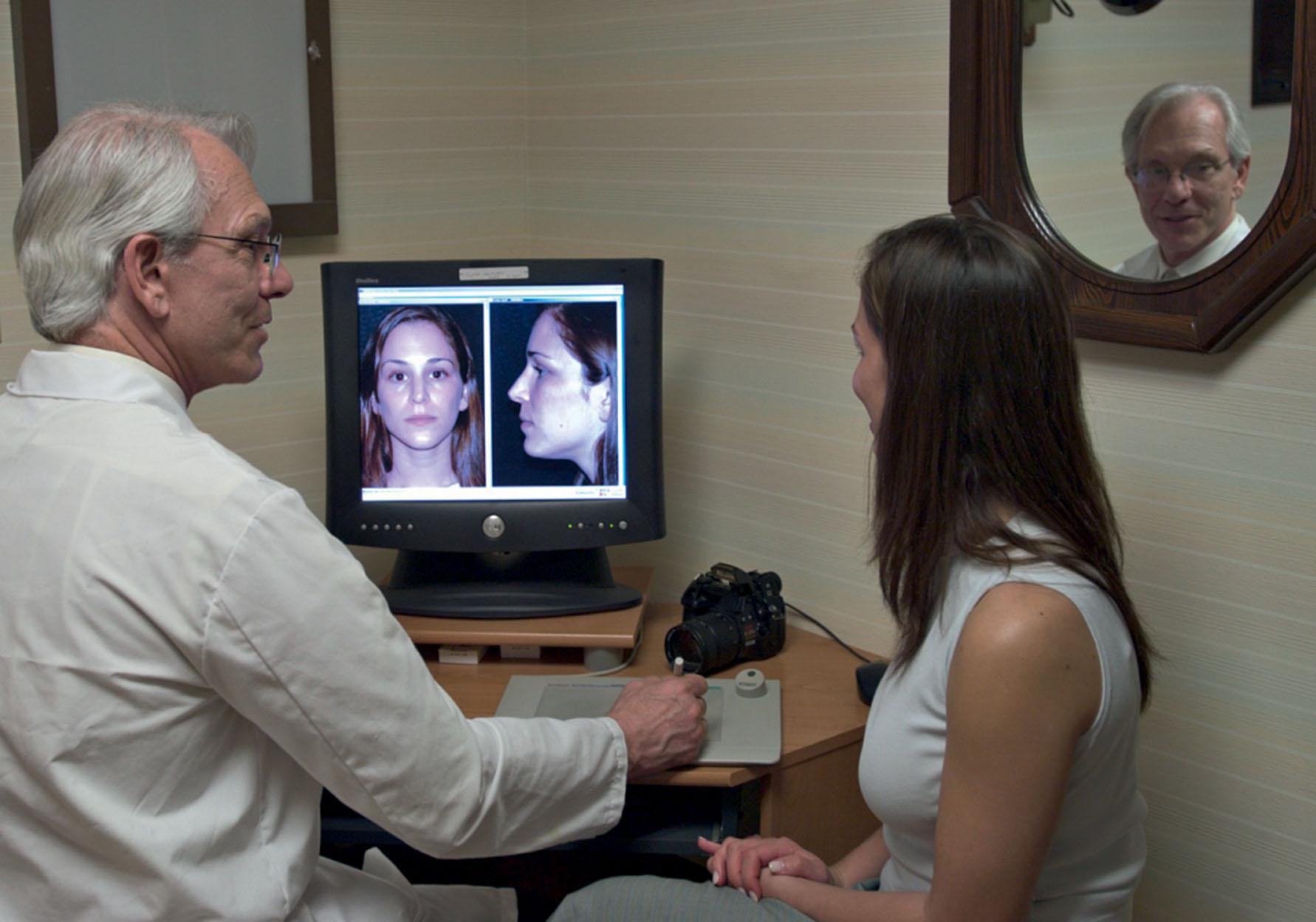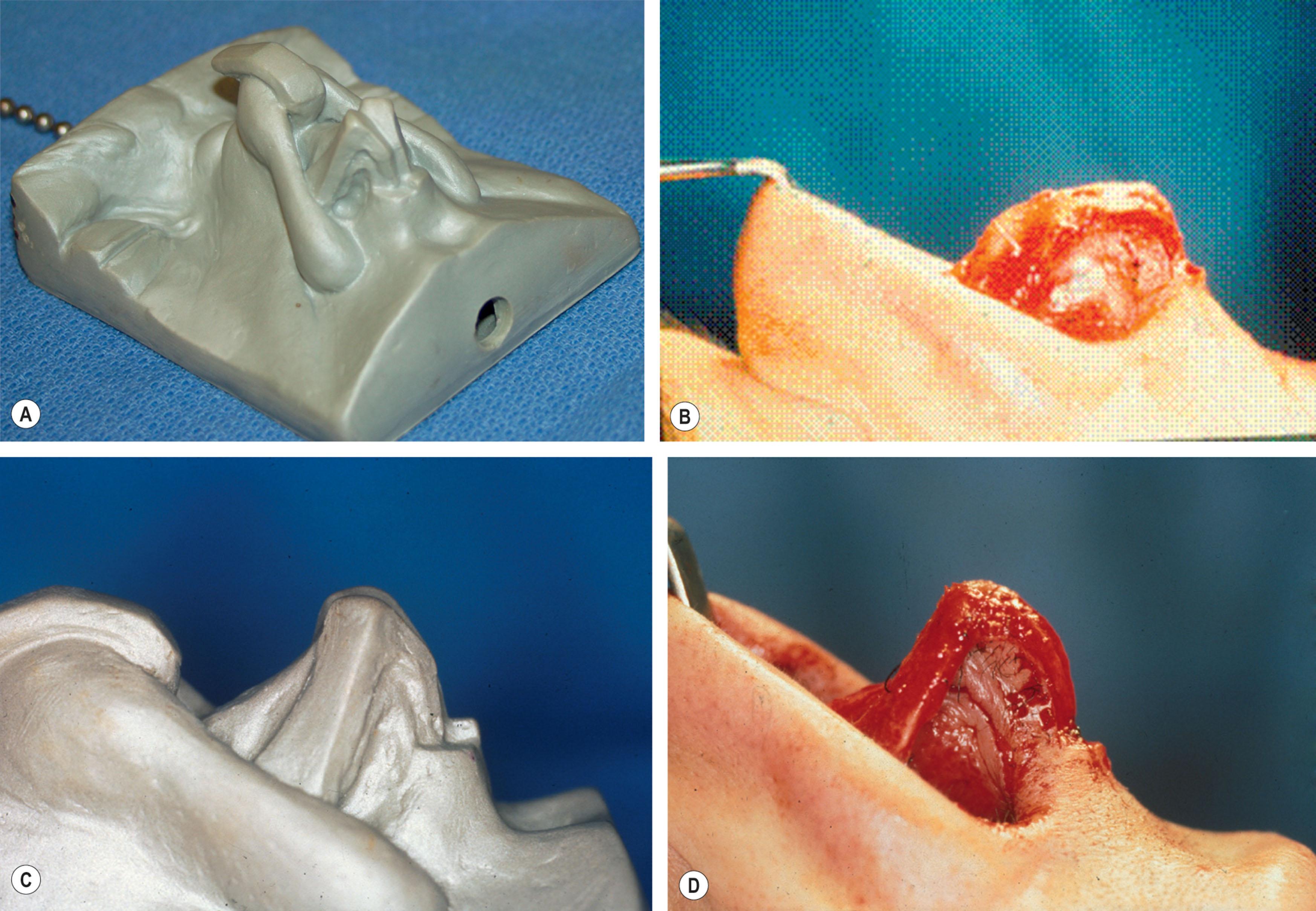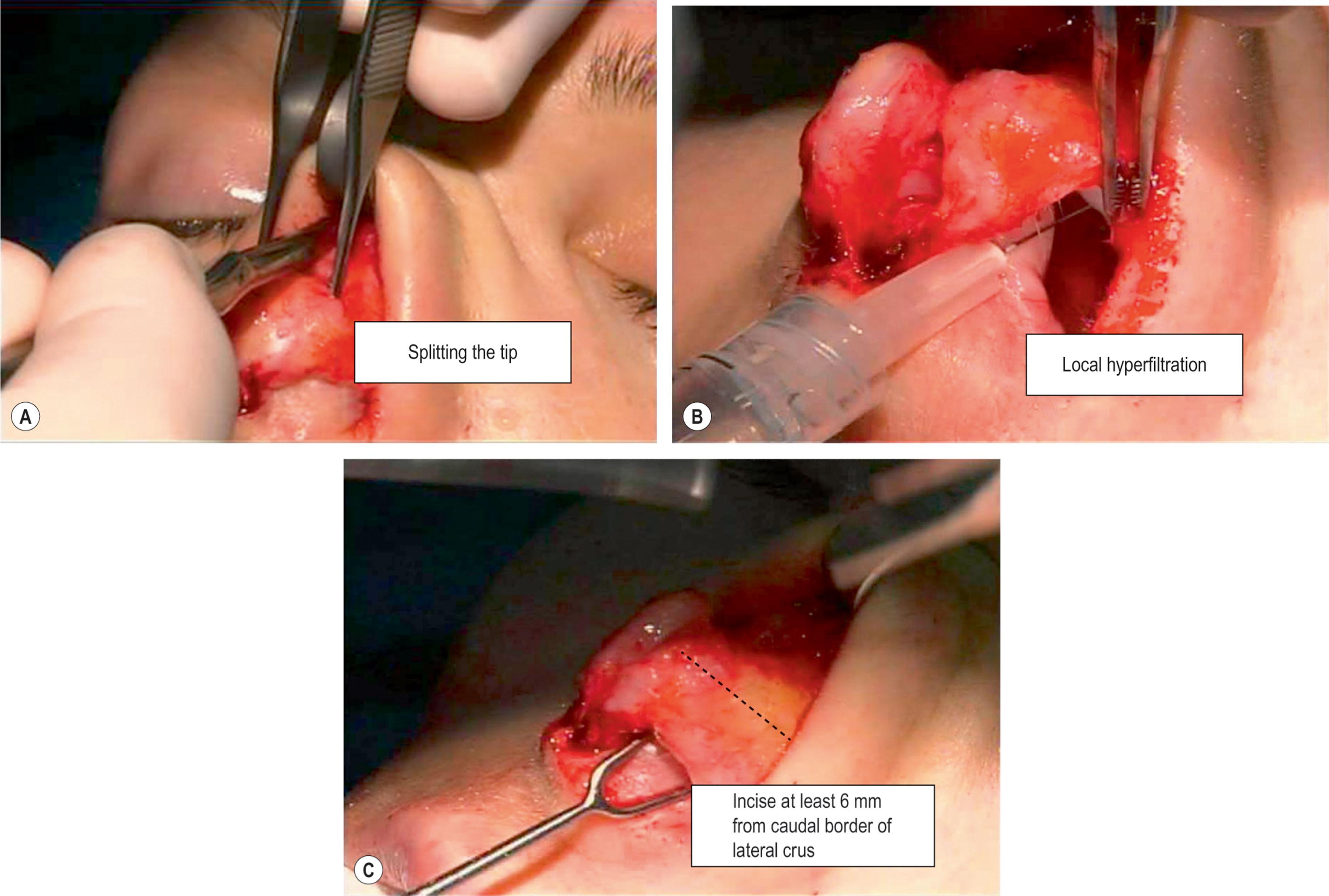Physical Address
304 North Cardinal St.
Dorchester Center, MA 02124
Secondary rhinoplasty may be done to correct a complication, to correct an untoward result, or simply to pursue further improvement.
Secondary rhinoplasty is more difficult than primary. All measures to help the surgeon should be used, including preoperative imaging and the intraoperative use of models.
Opening the nose is done by hyperinfiltration and patient dissection.
The nasal tip is “deconstructed” first by separating the lower lateral cartilages between the right and left middle/medial crurae as best as possible and not trying to dissect away all the scar tissue, which risks harming the structural integrity of the existing framework.
Suture techniques are attempted before cartilage grafting to restore structural integrity and shape. Batten grafts are used to avoid the additional tissue trauma resulting from undermining the framework from the vestibular skin.
Grafting of the surface of the lateral crus, upper lateral cartilage, or tip is the main reconstruction method. Invisible grafts, e.g., columellar struts and spreader grafts, are also relied upon.
Airway compromise is a frequent problem that must be addressed in secondary rhinoplasty. This includes septoplasty, internal valve reconstruction, and external valve reconstruction.
![]() Access video lecture content for this chapter online at Elsevier eBooks+
Access video lecture content for this chapter online at Elsevier eBooks+
Secondary rhinoplasty is a re-operation of a nose previously operated upon by a prior surgeon ( ![]() ). We distinguish this from a “revision”, which is a re-operation by the same surgeon on their own patient. Usually, the secondary operation is more extensive than the revision. Secondary rhinoplasty and revision rhinoplasty are done for reasons that include complications of surgery, unsatisfactory results, or the need for further improvement. For legal reasons, it is important to distinguish between (1) a complication; (2) an untoward result; and (3) the need for further improvement. A complication may or may not be attributable to an action taken by the surgeon. For example, a true saddle nose deformity is most likely the responsibility of the surgeon. However, a supratip deformity is usually an untoward result, even though more often than not we think it can be prevented. Seeking “further improvement” is done on a satisfactory result when the patient feels that more can be done to obtain an even better result and the surgeon feels that additional surgery can meet that goal.
). We distinguish this from a “revision”, which is a re-operation by the same surgeon on their own patient. Usually, the secondary operation is more extensive than the revision. Secondary rhinoplasty and revision rhinoplasty are done for reasons that include complications of surgery, unsatisfactory results, or the need for further improvement. For legal reasons, it is important to distinguish between (1) a complication; (2) an untoward result; and (3) the need for further improvement. A complication may or may not be attributable to an action taken by the surgeon. For example, a true saddle nose deformity is most likely the responsibility of the surgeon. However, a supratip deformity is usually an untoward result, even though more often than not we think it can be prevented. Seeking “further improvement” is done on a satisfactory result when the patient feels that more can be done to obtain an even better result and the surgeon feels that additional surgery can meet that goal.
If rhinoplasty is the most difficult operation in aesthetic surgery, secondary rhinoplasty is even more challenging. The estimated overall revision rates of 15%–20% suggests that this is the case. Whereas the patient who needs a revision rhinoplasty is willing to let the first surgeon perform it, they are much less likely to allow a third procedure by that surgeon if there is dissatisfaction once again. It behooves the surgeon, therefore, in a revision rhinoplasty, to do everything possible to avoid an unhappy patient with its concomitant problems (lawsuit and public complaining on the internet).
Dealing with the secondary rhinoplasty patient requires more skill and patience than a primary case. The patient initially presented for surgery because they did not like the appearance of their nose. After the primary rhinoplasty, the patient may perceive their nose to be worse than prior to surgery and likely are now even more focused on its appearance. As a result, the patient is often unhappy, skeptical, and needs more reassurance than they did prior to their first surgery. The operation is often more complicated, but not necessarily so. It is important to acknowledge the patient's complaints. However, one must always remember not to be judgmental of the first surgeon. Untoward and unsatisfactory results are a part of rhinoplasty. The nose is an unforgiving part of the anatomy. Even the very best rhinoplasty surgeons in the world have had to contend with the unhappy patient.
First, it is important to obtain a good history and physical examination. One wants to try and visualize through the skin the underlying framework to aid in decision making regarding technical aspects of the surgery. It is important to evaluate the septum and determine if any cartilage may be available to harvest for grafts. Finally, obtaining prior records from the previous surgeries can be helpful in understanding the prior relationship doctor–patient and surgical technique.
J.P. Gunter has probably done more than any other surgeon to emphasize analysis. Kim and Toriumi have a complete review on this subject, and it is also covered in Chapter 18 . In our practices, we consider digital imaging a helpful tool for analysis and communication. The surgeon should use imagers ( Fig. 22.1 ) for preoperative planning for each patient. Imagers are widely available and economical. It is helpful to demonstrate to the patient what you think should to be done and elicit their feedback as to what they think should be done. The patient needs to know what you think you can and cannot achieve. In the process of imaging, the surgeon learns what problems may exist. Sometimes, the process of morphing can be enlightening. Often, what may appear to be the problem when judging the patient sitting in the examining chair is not the problem as seen by the camera on the monitor. Furthermore, some anatomic problems only become obvious when on the monitor. Patients with expectations that cannot be achieved with rhinoplasty surgery can be filtered out by this process. Morphing with an imager is a form of mock surgery.

It can also be helpful to have the patients show you in their photos what they are unhappy with. Since the introduction of the phone camera, it is not uncommon for patients to base their goals for surgery on their appearance in the “selfie.” Viewing these images with the patient can help to gain an understanding of whether or not you feel you can meet their goals with surgery.
It is not enough to have knowledge of nasal anatomy; rhinoplasty is sculpting with a biological medium (cartilage and bone). As such, we need to employ an artist's principle: copying. It is much easier to copy a beautiful structure than it is to create it from memory. Commercial artists rely on this concept. Unless you are a naturally gifted artist, you will find this to be the case. Few of us can draw a decent picture of a cat from memory, but even an artistically challenged individual can copy a reasonable facsimile of a cat from a photograph. Consequently, we recommend the use of an intraoperative model of the ideal or prototype nasal framework ( Fig. 22.2 ![]() ). Magnifiers and loupes make it difficult to see the nose from a distance and get the proper perspective. Therefore, it can also be helpful to have a video camera in the operating room (which gives a profile view of the patient – from a distance – at all times). It is not surprising that some surgeons are occasionally perplexed to see that the patient's nose has nostril exposure the next day or at the time of splint removal. They may have neglected to judge that angle accurately when the patient was in the supine position. Stepping back to evaluate the patient and viewing from all angles, or using a video camera, gives a better perspective and helps avoid this problem.
). Magnifiers and loupes make it difficult to see the nose from a distance and get the proper perspective. Therefore, it can also be helpful to have a video camera in the operating room (which gives a profile view of the patient – from a distance – at all times). It is not surprising that some surgeons are occasionally perplexed to see that the patient's nose has nostril exposure the next day or at the time of splint removal. They may have neglected to judge that angle accurately when the patient was in the supine position. Stepping back to evaluate the patient and viewing from all angles, or using a video camera, gives a better perspective and helps avoid this problem.

The decision to open the nose or not in a secondary can be more difficult than in the case for a primary rhinoplasty. If there is little to do, e.g., rasping the dorsum or attaching a rim graft, there is no question that a closed approach is ideal. And if it appears that visualization will be beneficial to completing the task, e.g., straightening the nose, or straightening out a twisted tip, there will be little question that an open approach will permit greater accuracy and therefore a better final result.
Most of our patients receive conscious intravenous sedation because it is more affordable for the patient. The overall benefits of conscious sedation are reviewed elsewhere. Unfortunately, many residency programs do not train surgeons to use it, forcing them to learn it following their formal training. Patients are instructed to take flurazepam (Dalmane) 60 mg 1 h prior to arriving at the surgery center. On arrival, the relaxed patient then receives intramuscular (IM) hydroxyzine (Vistaril) 100 mg and IM nalbuphine (Nubain) 10 mg. Demerol 50 mg can be used as an alternative to nalbuphine. In the operating room, the patient is sedated with incremental 1-mg doses of midazolam (Versed). When the patient has difficulty counting backward from 100, ketamine 30 mg is given slowly over 30 s. For larger female patients and males, 50 mg is employed. Additional incremental doses of Versed (1 mg) are used if the patient should not enter that desired “dissociative state” that ketamine is known to produce, which lasts for approximately 5 min.
Local anesthetic is injected into the nose during that time. It consists of a solution containing a 50/50 mixture of xylocaine 1% and bupivacaine (Marcaine) 0.25% with an epinephrine concentration of 1/200 000. A total solution of 30–50 mL is used in a hyperinfiltration technique. Injection of the dorsal septum provides most of the anesthesia to the septum although supplementary anesthesia is given to other areas. The inferior turbinates are injected to provide anesthesia for a subsequent lateral osteotomy and to be able to tolerate the pledgets that are inserted to absorb blood that would otherwise run down the patient's nasopharynx and cause intermittent coughing. Using the above approach has avoided the need for topical anesthetics such as cocaine.
If one is going to undertake conscious anesthesia, it is imperative that they are familiar with airway management. It is a good idea to mask-ventilate the patient for a few breaths during ketamine to appreciate what the patient's potential airway difficulty might be during the case. It is also important to have an oral airway immediately available should it be necessary to insert it if the oximeter indicates that the patient is hypoventilating or their jaw has fallen back causing a partial airway obstruction. In addition, it is important to have available reversal agents including naloxone (Narcan) for the narcotics and flumazenil (Romazicon) for the benzodiazepines. When general anesthesia is used, the epinephrine concentration is increased to 1/70 000. To avoid an adverse cardiac reaction, a small dose is injected into the septum to observe the cardiac response before proceeding with further injection of the nose.
The secondary nose may have a great deal of scar tissue that obliterates much of the anatomy of the tip. Therefore, it is important to appreciate the situation by using a technique that makes it easier to (1) elevate the skin flap, and (2) deal with the distorted anatomy camouflaged by scar tissue. We have found that hyperinfiltration of the tissues will aid in hydrodissection of the subcutaneous plane and help to minimize the risk of perforating the skin. Patience is imperative as one frequently must go slowly to elevate the flap and minimize trauma to the soft tissues. Trauma to the cartilaginous frame is much less of a concern because it can always be rectified with sutures and grafts.
Once the flap is elevated, the first thing to do is to take account of the anatomy and to see if the underlying framework is what was anticipated based on the initial physical examination of the nose. By doing so, one can confirm the diagnosis and surgical plan or consider what alterations might be needed to the surgical plan to account for unforeseen anatomy.
The initial maneuver after making the diagnosis is to separate the right and left tip cartilages down the middle starting along the dorsum ( Fig. 22.3A ). When cutting the dorsal tissues, one usually finds the anterior septal cartilage by simple palpation. Any small perforation of the mucosa should be repaired with 5-0 plain catgut suture. As the cut separates the two lower lateral cartilages in the dome region, the middle crura often come into view. Even if they do not appear, and even if the splitting process results in a middle crus on one side that has extra cartilage on its surface and an opposite middle crus that is devoid of some cartilage because the splitting process did not precisely separate the two, it does not matter. There will be enough integrity of the two sides, such that when they are put together at the end of the tip-plasty, their structural integrity will be restored. If necessary, a columellar strut between them will restore that integrity and strength. Do not try to dissect off the scar tissue of the tip cartilages hoping to find a satisfactory framework. This typically damages the cartilages. It is better to leave some scar tissue on the surface. Trying to strip away scar tissue to see the cartilage should be minimized if one wants to avoid damaging the structural integrity. That is true when trying to visualize the lateral crura as well. It is reasonable to shave some scar tissue off the lateral crus. However, as soon as some cartilage is seen, that process should stop because continued dissection of the lateral crus will only weaken its structural integrity. The scar tissue will add some structural integrity to the cartilage. Making it as thin as possible by shaving scar off the surface is reasonable; however, grafts (see discussion of batten grafts later) may need to be applied to provide structural integrity.

Following splitting the two lower lateral cartilages of the tip down the middle and some superficial shaving of scar tissue from the lateral crus, the tip complex should be separated from the middle vault (upper lateral cartilages). The tip will become a mobile unit if this is done properly. One should try to find the junction between upper lateral cartilages (ULC) and lateral crus by simply moving the tip complex with a pair of forceps. Usually, the lateral crus folds onto the ULC when this is done. If that is not seen, one should arbitrarily draw a line with a marking pencil to preserve at least 6 mm from caudal border of the lower lateral cartilage. That line will arbitrarily become the border between lateral crus and ULC. The tissues of the vestibule are hyper infiltrated ( Fig. 22.3B ), and an incision is arbitrarily made where marked ( Fig. 22.3C ). There may or may not be sufficient cartilage in the region that is now indicated as the lateral crus. If it is not stable, it will need grafting. More often than not it is stable because most surgeons these days preserve 6–7 mm of lateral crus in a primary rhinoplasty and do not resect or divide the lateral crus, as was done years ago to reduce tip bulbosity. The incision between the ULC and lateral crus should not penetrate the vestibular lining. The gap is widened with scissors. Surprisingly, the gap can be as much as 4–8 mm. It results in a tip mobility that allows the surgeon to de-rotate or rotate the tip to a new position without tension. When the separation of the lower lateral cartilages is complete, when some shaving of scar tissue has been done, and when the tip complex is mobile, deconstruction will have been completed and the surgeon will now be ready to reconstruct the tip complex. That reconstruction process will, in essence, be very similar to the primary rhinoplasty and involve all the principles of primary rhinoplasty. The surgeon will also be able to perform a septoplasty starting at the anterior septal angle, which has now been exposed as a result of the tip-splitting process.
Become a Clinical Tree membership for Full access and enjoy Unlimited articles
If you are a member. Log in here